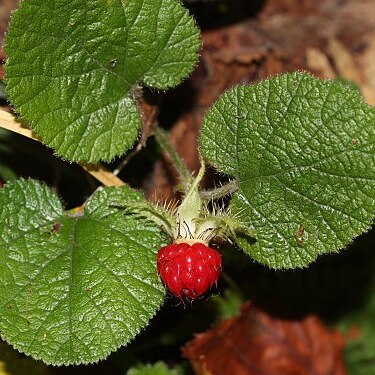Main stems thin and wiry, creeping, up to 2 m long, rooting, with up to 20 cm long, erect, little or not branched laterals, all stems patendy soft-hairy, prickles rather few, up to 3 mm. Leaves reniform, 2-5.5 by 2-6 cm, shallowly 3(-5)-lobed, base deeply cordate, margin serrate, apex rounded, thinly herbaceous, nervation pedate with (l-)2 pairs of main side-nerves, venation widely reticulate, upper surface long-hairy between the veins, lower surface long-hairy and with needlelike prickles on nerves and veins. Petiole (l-)2-6 (-8) cm long. Stipules up to 8 by 10 mm, deeply digitately divided into up to 8 lobes. Flowers solitary, terminal on the laterals, rarely also 1-2 flowers in the axils of the upper (reduced) leaves, up to 3 cm stalked above uppermost true leaf. Hypanthium 3-4(-6) mm across, with long, soft, patent hairs and many needle-like, up to 4 mm long prickles outside. Sepals elliptic, 8-10 by 3-10 mm, growing to 12 by 13 mm in fruit, exposed margins pinnately 5-10-lobed, indumentum outside as hypanthium. Petals elliptic, 10-13 by 6-9 mm, white. Stamens 16-30, glabrous, filaments up to 5 mm, anthers 1-1.2 mm long. Pistils 24-40, ovaries with few long hairs, on elevated, hairy torus, the styles 3-4 mm long. Fruits orange to red, mesocarp thin, juicy, stone 2.5-3 mm long, endocarp smooth at first, later rugulose.
A trailing plant with heart shaped leaves. It grows about 1 m long. The stems, leaves and outer layer of sepals are armed with small spines. The leaves are rough, hairy, heart shaped and toothed. They are 3-6 cm across. The flowers are white and the fruit 1.5 cm across. They are bright red and juicy.

